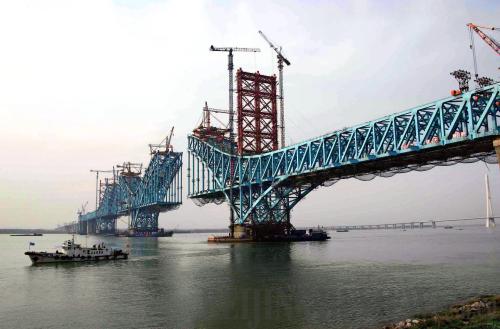|
 |
|
COAST TO COAST: The Nanjing Dashengguan Bridge, part of the Beijing-Shanghai High-Speed Railway, is set to reach completion soon after three years of construction (YUAN RUILUN) |
Most everyday train passengers don't have time, or reason, to ponder the technicalities of the rails, wheels and engines beneath his or her feet. But inevitably questions will pop up. What kind of quality technologies do China's high-speed railways utilize? How are they maintained? And are they safe?
"China has mastered a complete set of high-speed railway technologies that integrate designing, construction, equipment manufacturing, train control and system integration, as well as daily operation and management, forming a high-speed railway technology system with independent intellectual property rights at a global advanced level," said a news release from the Ministry of Railways (MOR).
The release also says that although high-speed railway technologies originated in Japan, Germany and France, China has made independent innovations when absorbing technologies from abroad. With a series of significant technological achievements, China has become a world leader in high-speed railway technologies. The fastest train operating in the world is in China (CRH trains), and it features the best system integration capabilities, covers the longest distance and is the largest construction project of its kind anywhere in the world.
Thanks to China's achievements in high-speed rail construction, Beijing is honored to host the Seventh World Congress on High Speed Rail in December 2010.
Technological breakthroughs
China currently has three high-speed rails operating above 350 km per hour, all of which were built on different terrain, presenting multiple challenges—the Beijing-Tianjin Intercity Railway is built on a mollisoil bed, Wuhan-Guangzhou High-Speed Railway on a karst bed and Zhengzhou-Xi'an High-Speed Railway on a collapsible loess bed. Construction of railways, particularly high-speed railways, on such geological conditions is unprecedented, even in Japan, Germany and France. To build the railways, China had to overcome numerous design obstacles before setting out to complete the high-speed projects.
The MOR noted the three high-speed railways are operating stably and efficiently, a testament to China's ability to master treatment technologies of railway beds with complicated geological conditions.
To save land, an array of bridges were built during the construction of high-speed railways, particularly over sections that span major rivers. On Chinese high-speed railways operating now, three of these viaducts stand out: the Wuhan Tianxingzhou Bridge, Nanjing Dashengguan Yangtze River Bridge and Jinan Yellow River Bridge. The three structures hold world records in terms of span, load-bearing capacity and width.
Tunnel construction also reflects the degree of difficulty facing China as it strives to construct a massive high-speed network. The Wuhan-Guangzhou High-Speed Railway has tunnels running through the Dayao Mountain and crossing the Liuyang River near Changsha, capital of Hunan Province. Cross-sections of these tunnels are 160 meters wide, and trains pass through at speeds of 350 km per hour, an unprecedented accomplishment among high-speed rails worldwide.
As for track technologies, high-speed railways in France use ballasted tracks (tracks stabilized with small, crushed stones), while those in Germany and Japan use ballastless tracks. According to the MOR release, with systematic and comprehensive research on ballastless tracks, China has solved the problem of electric current coverage between ballastless tracks and rails, which other countries have never encountered.
|
